David W Peate
Research
page maintained by
David Peate © 2013
Current Research Projects
Opportunities are available for motivated graduate students (M.S. and Ph.D.) to be involved in research projects in my lab, not necesarily limited to those listed below. Please e-mail me for more information.
I have a broad range of research interests, and I'm happy to work with students to find a mutually interesting research topic. At the moment I am particularly interested in research projects that involve high quality trace element data that can be obtained with the inductively coupled plasma mass spectrometer (ICP-MS) and laser ablation system in my lab, as well as analysis of major elements in glasses / minerals using the newly-installed electron microprobe. Most of my research focuses on understanding the origins of magmas, the processes that modify magma compositions, and the time scales of these processes. This work is done primarily through determining elemental and isotopic compositions of volcanic rocks and minerals. I am also interested in applications of geochemistry to addressing research problems in a broader range of subjects, such as environmental effects of large igneous provinces, impact cratering, sedimentary geochemistry, and geoarchaeology.
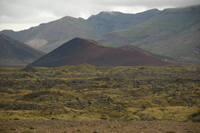
Icelandic magmatism
I have been researching the origins of Icelandic magmas for the last decade or so. This research is currently focused on the off-axis magmatism on the Snaefellsnes Peninsula, funded by NSF grant 1550415. More attention has been given to melt generation and storage in the Iceland rift zones because of their dominance on melt production, but the reasons for melt generation at large (~100 km +) distances from the rifts remain uncertain. The Snaefellsnes region in western Iceland includes the Snaefellsjokull volcano – made famous in Jules Verne's novel as the place where travellers could 'Journey to the Centre of the Earth'. The studyfocuses on how melts are generated and transported to the surface, to investigate the underlying cause of melting and how details of melt aggregation and transport through thick lithosphere contrasts with the extensional setting and thinner lithosphere of the rift zones. Crystallization depths will be estimated from glass analyses (using ol-cpx-plag saturation) and clinopyroxene thermobarometry, and melt diversity will be characterized with olivine-hosted melt inclusions and clinopyroxene compositions. Radiogenic isotopes and U-series disequilibria will be used to provide insights into the compositional heterogeneity and melting behavior of mantle sources and the process of melt extraction, and additional constraints on the details of melting will come from REE inversion models. The potential of high-precision minor element analyses of olivines to show involvement of non-peridotite sources for off-axis magmas will also be evaluated.
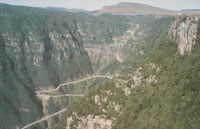
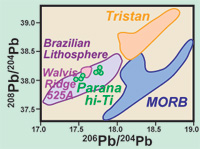
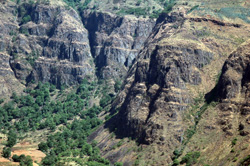
Origins and Environmental Impact of Large Igneous Provinces
Large igneous provinces represent some of the volumetrically most significant magmatic episodes in the Earth’s history. They are characterised by the rapid eruption of huge volumes of typically tholeiitic basaltic magmas. The ultimate driving force(s) behind the production of such large magma volumes are still the subject of considerable debate, with ideas ranging from impact of a mantle plume head, extension above a mantle plume, melting of lithospheric mantle, melting of recycled fertile eclogite material, small-scale edge convection at lithospheric discontinuities, and even impact melting. As these magmas pass through the crust, assimilation of crustal material can lead to significant modification of their mantle-derived compositional characteristics which complicates interpretations of lava compositions. A recent approach that we have taken is to study olivine- and plagioclase-hosted melt inclusions in primitive flood basalts to investigate crustal assimilation processes, and pre-eruptive volatile contents. Ryan Clark completed an M.S. thesis in 2006 on the petrogenesis of high-Ti/Y Paraná flood basalts, and Lee Falkena completed an M.S. thesis in 2009 on melt inclusions in silicic units in the Yemen large igneous province.
Large igneous provinces have frequently been invoked as a cause of global climate change, and the coincidence between the eruption of flood basalt sequences and geological stage boundaries in the stratigraphic record is striking. The immense size of many individual eruptive units, often traceable for up to hundreds of kilometers, has led to speculation as to the environmental effects of these eruptions, particularly the extent of volatile emissions during eruption, and the subsequent chemical weathering and impact on ocean chemistry. Graduate student Jaime Ricci is analysing the trace element and Pb isotope composition of Oligocene carbonate sediments from an ODP core in the Indian Ocean to see if we can see any regional environmental changes associated with the eruption of the Ethiopian-Yemen flood basalt province. I am also developing a new project to investigate the possible link between the eruption of the Paraná-Etendeka flood basalt province and the Valanginian Weissert oceanic anoxic event.
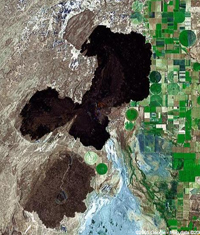

Monogenetic eruptions: plumbing systems & crustal assimilation
I am interested in understanding the details of how basaltic magmas assimilate crustal material en route to the Earth’s surface, and this involves major and trace element data and isotope data on whole rock sample of lavas and crustal xenoliths together with mineral compositions and data on inclusions of melt trapped within the crystallising phases. We have been studying both large scale systems (large igneous provinces) and small scale systems (monogenetic eruptions, such as Paricutin volcano). For the basaltic monogenetic systems, we are looking at compositional heterogeneity at different length-scales (whole rock samples vs. melt inclusions in crystals). Melt inclusions in olivine phenocrysts provide a window into the earlier stages of crustal assimilation and the melt aggregation processes in the magmatic plumbing systems feeding monogenetic eruptions, and allow assessment of the timing of assimilation relative to olivine growth. The diversity of melt inclusion compositions should allow us to determine the extent of crustal assimilation at different stages in the differentiation history of the magma to provide constraints on theoretical and experimental models for the mechanisms of crustal assimilation. Re-homogenized melt inclusions are analysed by EMP (major elements, Cl & S), and laser ablation ICP-MS or SIMS (trace elements). Jay Thompson completed an M.S. thesis on the Ice Springs basaltic lava flow in SW Utah and post-doc Mike Rowe studied Paricutin volcano in Mexico, and the Dotsero flow in Colorado.
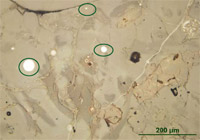
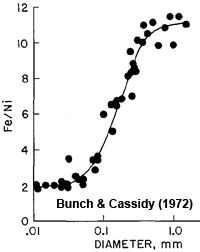
Geochemical Investigations of Impact Processes
I am interested in how the chemical composition of impact materials can be used to infer details of meteorite impact processes. Graduate student Dan Cukierski is studying the textural relations and compositions of FeNi metal droplets in impact glasses at the Monturaqui impact crater in Chile using a combination of 3-D X-ray tomography, and compositional analyses (SEM, LA-ICP-MS, EMP). The FeNi metal droplets are presumed to be derived from the iron meteorite impactor, but their compositions differ from iron meteorites and show systematic variations with size that must be formed via specific processes during the impact event. I am also working with Ingrid Ukstins Peate on analysing the composition of the target rocks and minerals and the impact melt glass to better quantify what materials contributed to the melt glass. I was fortunate to have an opportunity to visit the Monturaqui impact crater in Dec 2009 and collect samples, together with Ingrid and colleagues, as part of their NASA-funded spherules project (see expedition blog).
During the heyday of the K/T boundary controversy, the Manson impact crater in NW Iowa was the prime suspect for the site of the impact that caused the global Ir anomaly. Subsequent geochronological studies demonstrated that the crater age was c. 75 Ma, ten million years eariler that the K/T boundary. The crater site was intensively drilled by the USGS & IGS, and the cores are now archived at the Iowa Geological Survey. There is great potential to develop student projects based on this excellent resource (in collaboration with Ray Anderson and Brian Witzke at the Iowa Geological Survey).
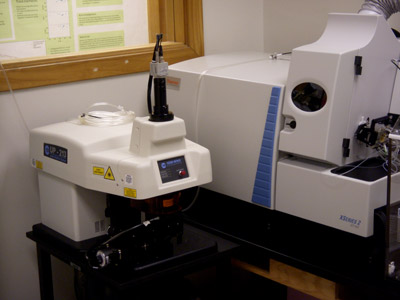
Trace element analaysis of geological & environmental materials
A trace element analytical facility was established in Nov 2009 with funding from the National Science Foundation and the University of Iowa, and houses a Thermo X-series II quadrupole ICP-MS and a NewWave 213 nm laser ablation system. I am interested in the applications and development of ICP-MS solution-based and laser ablation methods, and in collaborative projects that utilize trace element data.
Some recent examples of projects include:
• trace metal profiles through soil horizons.
• assessing the origins of reduction spots in slates.
• climate records preserved in Caribbean corals using LA-ICP-MS.
• REE variations in coal-ball carbonate concretions.
• hydrology of Manson impact crater aquifers.

